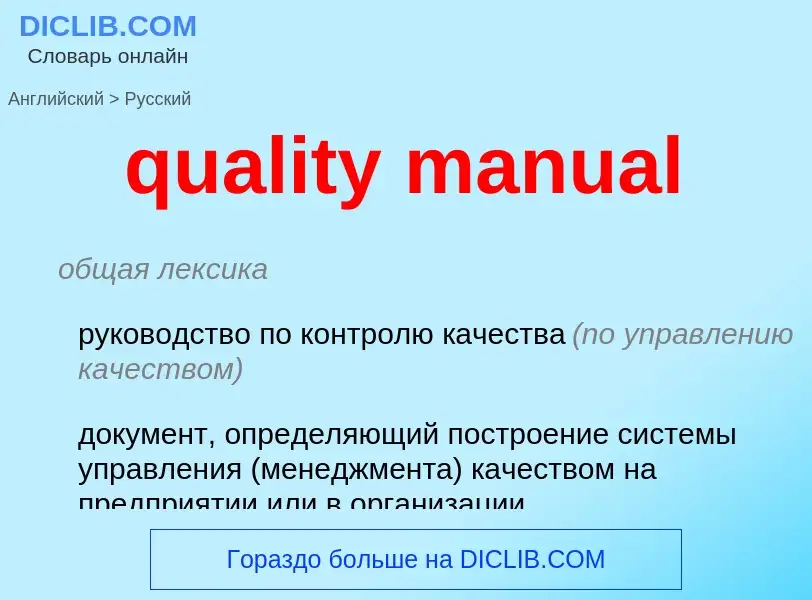Tradução e análise de palavras por inteligência artificial ChatGPT
Nesta página você pode obter uma análise detalhada de uma palavra ou frase, produzida usando a melhor tecnologia de inteligência artificial até o momento:
- como a palavra é usada
- frequência de uso
- é usado com mais frequência na fala oral ou escrita
- opções de tradução de palavras
- exemplos de uso (várias frases com tradução)
- etimologia
quality manual - tradução para Inglês
общая лексика
руководство по контролю качества (по управлению качеством)
документ, определяющий построение системы управления (менеджмента) качеством на предприятии или в организации
строительное дело
руководство по методам контроля качества
Смотрите также
Definição
Wikipédia
ISO/IEC 17025 General requirements for the competence of testing and calibration laboratories is the main ISO/IEC standard used by testing and calibration laboratories. In most countries, ISO/IEC 17025 is the standard for which most labs must hold accreditation in order to be deemed technically competent. In many cases, suppliers and regulatory authorities will not accept test or calibration results from a lab that is not accredited. Originally known as ISO/IEC Guide 25, ISO/IEC 17025 was initially issued by ISO/IEC in 1999. There are many commonalities with the ISO 9000 standard, but ISO/IEC 17025 is more specific in requirements for competence and applies directly to those organizations that produce testing and calibration results and is based on somewhat more technical principles. Laboratories use ISO/IEC 17025 to implement a quality system aimed at improving their ability to consistently produce valid results. It is also the basis for accreditation from an accreditation body.
There have been three releases; in 1999, 2005 and 2017. The most significant changes between the 1999 and 2005 release were a greater emphasis on the responsibilities of senior management, explicit requirements for continual improvement of the management system itself, and communication with the customer. It also aligned more closely with the 2000 version of ISO 9001
The 2005 version of the standard comprises five elements; Normative References, Terms and Definitions, Management Requirements, and Technical Requirements. Management requirements are primarily related to the operation and effectiveness of the quality management system within the laboratory. Technical requirements include factors that determine the correctness and reliability of the tests and calibrations performed in the laboratory.
The 2017 version of ISO/IEC 17025 has modified this structure to be Scope, Normative References, Terms and Definitions, General Requirements, Structural Requirements, Resource Requirements, Process Requirements, and Management System Requirements. General Requirements and Structural Requirements are related to the organization of the laboratory itself. Resource Requirements cite those issues related to the people, plant, and other organizations used by the laboratory to produce its technically valid results. Process Requirements are the heart of this version of the standard in describing the activities to ensure that results are based on accepted science and aimed at technical validity. Management System Requirements are those steps taken by the organization to give itself quality management system tools to support the work of its people in the production of technically valid results.


![1894 illustration of [[chain gang]] performing manual labour 1894 illustration of [[chain gang]] performing manual labour](https://commons.wikimedia.org/wiki/Special:FilePath/Chain gang illustration.png?width=200)
![Road construction by women in [[Myanmar]], (2019) Road construction by women in [[Myanmar]], (2019)](https://commons.wikimedia.org/wiki/Special:FilePath/MyanmarRoadConstruction1.jpg?width=200)
![Rail track construction, [[Kansas]], USA, 1974 Rail track construction, [[Kansas]], USA, 1974](https://commons.wikimedia.org/wiki/Special:FilePath/RAILROAD WORK CREW IMPROVES THE TRACKS AND BED OF THE ATCHISON, TOPEKA AND SANTA FE RAILROAD NEAR BELLEFONT, KANSAS... - NARA - 556012.jpg?width=200)
